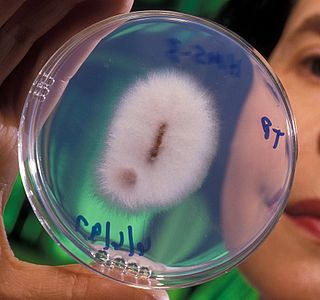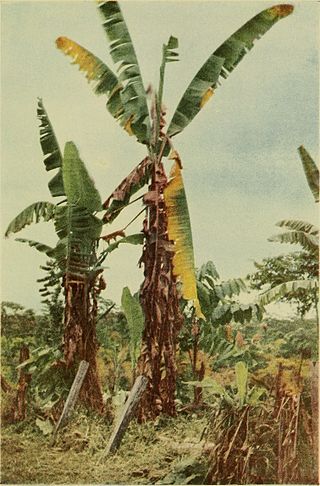
Fusarium ear blight (FEB), is a fungal disease of cereals, including wheat, barley, oats, rye and triticale. FEB is caused by a range of Fusarium fungi, which infects the heads of the crop, reducing grain yield. The disease is often associated with contamination by mycotoxins produced by the fungi already when the crop is growing in the field. The disease can cause severe economic losses as mycotoxin-contaminated grain cannot be sold for food or feed.

Fusarium oxysporum, an ascomycete fungus, comprises all the species, varieties and forms recognized by Wollenweber and Reinking within an infrageneric grouping called section Elegans. It is part of the family Nectriaceae.

Fusarium wilt is a common vascular wilt fungal disease, exhibiting symptoms similar to Verticillium wilt. This disease has been investigated extensively since the early years of this century. The pathogen that causes Fusarium wilt is Fusarium oxysporum. The species is further divided into formae speciales based on host plant.

Panama disease is a plant disease that infects banana plants. It is a wilting disease caused by the fungus Fusarium oxysporum f. sp. cubense (Foc). The pathogen is resistant to fungicides and its control is limited to phytosanitary measures.

Fusarium is a large genus of filamentous fungi, part of a group often referred to as hyphomycetes, widely distributed in soil and associated with plants. Most species are harmless saprobes, and are relatively abundant members of the soil microbial community. Some species produce mycotoxins in cereal crops that can affect human and animal health if they enter the food chain. The main toxins produced by these Fusarium species are fumonisins and trichothecenes. Despite most species apparently being harmless, some Fusarium species and subspecific groups are among the most important fungal pathogens of plants and animals.
Fungal keratitis is a fungal infection of the cornea, which can lead to blindness. It generally presents with a red, painful eye and blurred vision. There is also increased sensitivity to light, and excessive tears or discharge.
Mycotoxicology is the branch of mycology that focuses on analyzing and studying the toxins produced by fungi, known as mycotoxins. In the food industry it is important to adopt measures that keep mycotoxin levels as low as practicable, especially those that are heat-stable. These chemical compounds are the result of secondary metabolism initiated in response to specific developmental or environmental signals. This includes biological stress from the environment, such as lower nutrients or competition for those available. Under this secondary path the fungus produces a wide array of compounds in order to gain some level of advantage, such as incrementing the efficiency of metabolic processes to gain more energy from less food, or attacking other microorganisms and being able to use their remains as a food source.

Fusarium culmorum is a fungal plant pathogen and the causal agent of seedling blight, foot rot, ear blight, stalk rot, common root rot and other diseases of cereals, grasses, and a wide variety of monocots and dicots. In coastal dunegrass, F. culmorum is a nonpathogenic symbiont conferring both salt and drought tolerance to the plant.

Gibberella zeae, also known by the name of its anamorph Fusarium graminearum, is a fungal plant pathogen which causes fusarium head blight (FHB), a devastating disease on wheat and barley. The pathogen is responsible for billions of dollars in economic losses worldwide each year. Infection causes shifts in the amino acid composition of wheat, resulting in shriveled kernels and contaminating the remaining grain with mycotoxins, mainly deoxynivalenol (DON), which inhibits protein biosynthesis; and zearalenone, an estrogenic mycotoxin. These toxins cause vomiting, liver damage, and reproductive defects in livestock, and are harmful to humans through contaminated food. Despite great efforts to find resistance genes against F. graminearum, no completely resistant variety is currently available. Research on the biology of F. graminearum is directed towards gaining insight into more details about the infection process and reveal weak spots in the life cycle of this pathogen to develop fungicides that can protect wheat from scab infection.
Gibberella xylarioides is a species of fungus in the family Nectriaceae. It is the causative agent of coffee wilt disease (CWD). The disease caused a severe problem in several countries in West and East Africa during the 1940s and 1950s. CWD was first seen in Coffea liberica.
Fusarium proliferatum is a fungal plant pathogen infecting crops and also can affect humans as well.
Fusarium redolens is a species of fungus in the genus Fusarium and family Nectriaceae. This species is a soil-borne plant pathogen in temperate prairies. It causes diseases such as root, crown, and spear rot, seedling damping-off, and wilting disease. It is a known producer of the alkaloids peimisine and imperialine-3β-d-glucoside, which has implications for traditional Chinese medicine.
Fusarium sporotrichioides is a fungal plant pathogen, one of various Fusarium species responsible for damaging crops, in particular causing a condition known as Fusarium head blight in wheat, consequently being of notable agricultural and economic importance. The species is ecologically widespread, being found across tropical and temperate regions, and is a significant producer of mycotoxins, particularly trichothecenes. Although mainly infecting crops, F. sporotrichioides-derived mycotoxins can have repercussions for human health in the case of the ingestion of infected cereals. One such example includes the outbreak of alimentary toxic aleukia (ATA) in Russia, of which F. sporotrichioides-infected crop was suspected to be the cause. Although current studies on F. sporotrichioides are somewhat limited in comparison to other species in the genus, Fusarium sporotrichioides has found several applications as a model system for experimentation in molecular biology.

Fusarium solani is a species complex of at least 26 closely related filamentous fungi in the division Ascomycota, family Nectriaceae. It is the anamorph of Nectria haematococca. It is a common soil inhabiting mold. Fusarium solani is implicated in plant diseases as well as in serious human diseases such as fungal keratitis.

Pseudallescheria boydii is a species of fungus classified in the Ascomycota. It is associated with some forms of eumycetoma/maduromycosis and is the causative agent of pseudallescheriasis. Typically found in stagnant and polluted water, it has been implicated in the infection of immunocompromised and near-drowned pneumonia patients. Treatment of infections with P. boydii is complicated by resistance to many of the standard antifungal agents normally used to treat infections by filamentous fungi.

Richard C. Summerbell is a Canadian mycologist, author and award-winning songwriter. He was editor in chief of an international scientific journal in mycology from 2000 to 2004. In the 1970s and 80s, he was a gay activist and an early commentator on (then) controversial topics such as AIDS and promiscuity and attitudes to homosexuality in organized religion.

Fusarium circinatum is a fungal plant pathogen that causes the serious disease pitch canker on pine trees and Douglas firs. The most common hosts of the pathogen include slash pine, loblolly pine, Monterey pine, Mexican weeping pine, and Douglas fir. Like other Fusarium species in the phylum Ascomycota, it is the asexual reproductive state of the fungus and has a teleomorph, Gibberella circinata.

Microbial corneal infection is the most serious and "most common vision threatening" complication of contact lens wear, which is believed to be strongly associated with contact lens cases. Such infections "are being increasingly recognized as an important cause of morbidity and blindness" and "may even be life-threatening." While the cornea is believed to be the most common site for fungal eye infections, other parts of the eye such as the orbit, sclera, eyelids, and more may also be involved. Contact lens cases are recognized as a "potential source of pathogens associated with corneal ulcers" and according to Moorfields Eye Hospital, contact lens wear is “the most prevalent risk factor for new cases of corneal ulcers.” Contaminants "isolated from contact lens associated corneal ulcers have often been shown to be" the same as found in the patient's contact lens case, thus providing evidence contaminated contact lens cases may be a "replenishable source of pathogenic microbes."

Fusarium mangiferae is a fungal plant pathogen that infects mango trees. Its aerial mycelium is white and floccose. Conidiophores on aerial mycelium originating erect and prostrate from substrate; they are sympodially branched bearing mono and polyphialides. Polyphialides have 2–5 conidiogenous openings. Phialides on the aerial conidiophores mono- and polyphialidic. Sterile hyphae are absent. Microconidia are variable in shape, obovoid conidia are the most abundant type, oval to allantoid conidia occurring occasionally. Microconidia mostly 0-septate with 1-septate conidia occurring less abundantly. Sporodochia are present. Macroconidia are long and slender, usually 3–5 septate. Chlamydospores are absent.
Sudden death syndrome (SDS), a disease in soybean plants, quickly spread across the southern United States in the 1970s, eventually reaching most agricultural areas of the US. SDS is caused by multiple Fusarium fungi in the Fusariumsolani complex. Fusarium virguliforme is the sole causal agent in North America. In South America, Fusarium brasiliense, F. cuneirostrum, F. tucumaniae, and F. virguliforme are all causal agents. Losses could exceed hundreds of millions of dollars in US soybean markets alone making it one of the most important diseases found in Soybeans across the US.












